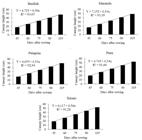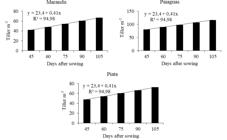ABSTRACT.
This study aimed was the establishment of the genus Brachiaria in the Brazilian semi-arid region. The experiment was conducted from April to June 2016, as a randomized-block experimental design with five treatments and four replicates. Treatments were represented by five Brachiaria cultivars, namely, Marandu, Paiaguás, Piatã, Xaraés and Basilisk. Morphogenetic (leaf appearance rate, leaf elongation rate e stem elongation rate) and structural characteristics (final leaf length, tiller population density e number of leaves per tiller, forage mass, leaf blade mass, stem mass, senescent material mass and leaf:stem ratio) of the forage cultivars were evaluated. Canopy height fitted a linear regression model (P<0,05), with estimated daily increases of 0.50, 0.53, 0.53, 0.54 and 0.56 cm for cvs Basilisk, Marandu, Paiaguás, Piatã and Xaraés, respectively. The number of live leaves in cvs Basilisk and Paiaguás increased linearly (p < 0.05), by 4.3 and 2.8 leaves per tiller, respectively, during the 60-day period. The recommended height at which the growth of Brachiaria cultivars should be interrupted is upon reaching 25 to 35 cm. In the soil-climatic conditions of the Brazilian semi-arid region, the Brachiaria cultivars Basilisk, Marandu, Paiaguás, Piatã and Xaraés are established at 75 days after sowing, which is the recommended time for performing the first harvest or lenient grazing to stimulate tillering.
Keywords:
herbage; implementation; pasture; Quartzipsamment

 Thumbnail
Thumbnail
 Thumbnail
Thumbnail
 Thumbnail
Thumbnail
 Thumbnail
Thumbnail
 Thumbnail
Thumbnail




